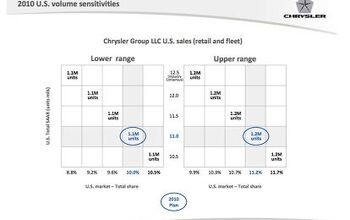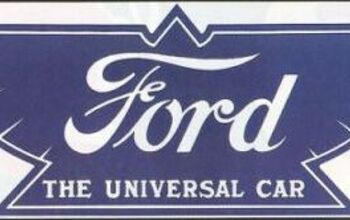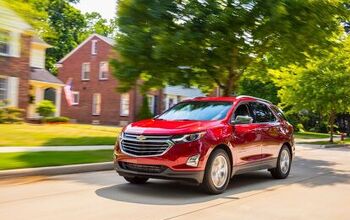Year-End Sales Report: General Motors
On the surface, GM had a fairly passable 2010, as the newly-public automaker posted a 21.3% volume increase for its four core brands. In contrast to Toyota’s humbly grateful tone, GM’s VP of US Sales Don Johnson sounded a distinctly triumphal note, arguing
Our sales this year reflect the impact of GM’s new business model. The consistency of results that we achieved demonstrates the focus on our brands, dealers and customers, and how we compete aggressively for every sale, every day.
And on a superficial level, the argument certainly seems to ring true, as Buick (+51.9%), Cadillac (+34.7%), and GMC (+31.7%) were the three most-improved brands in the business last year in terms of volume. GM also delivered more vehicles than any other automaker last year, with 2,215,227 vehicles sold. Great success, end of story… right?
Wrong.
As long as the story stays on the three non-Chevy brands, the story stays happy. Buick enjoyed strong improvement in retail market share, rising .3% to match Acura at 1.4%. That seems in line with what should be reasonably expected for an entry-luxe brand, though it may be a bit disappointing when you consider the brand-new Regal is barely outselling the ancient Lucerne. Also, 52% growth isn’t quite as satisfying when you realize that, at 53,083 units, Buick’s volume improvement is a fraction of what one hot new sedan can achieve on its own (witness the Sonata’s 76,595-unit growth last year). Still, Buick has reclaimed more credibility on the market than would have seemed possible just last year (when Buick fell by 25%).
GMC’s 28.9% growth brought GM’s truck brand back over 300k units last year, en route to a .4% improvement in retail market share and 4% of the retail market. Which creates an interesting contrast: even though GMC grew slower (in terms of percentages) than the other non-Chevy brands, its retail market share was the best and the fastest-growing of the bunch. Of course trucks did better than cars last year, but that still doesn’t bode well for GM’s ( magnesium-framed) future… and it hints at the lurking problem underlying GM’s entire 2010 performance (patience… we’re getting there).
Underlying Cadillac’s 34.7% volume growth was the most modest retail market share improvement of the non-Chevy brands, a bump of .2% to 1.3%. With Lexus, Mercedes and BMW battling for the luxury volume crown, Cadillac is but a bystander, with most of its 37,833-unit improvement coming from a 30k-and-change bump in SRX volume. But at 45,656 units, CTS is still competing with BMW’s MINI Cooper (45,644) rather than BMW’s 3-Series, which sold over twice the CTS’s volume. The Escalade variations added only about 2k units to the brand, while DTS and STS combined for a small drop in volume. With a full compliment of CTS bodystyles (sedan, coupe, wagon), GM is out of ways to goose its main model’s sales, which means both it and the SRX’s strong performance must continue unabated for Cadillac to grow. The Standard Of The World is now essentially a two-car brand.
But the real trouble for GM involves its most crucial brand: Chevrolet. Chevy’s growth was slowest among GM brands in terms of percentages, as the bowtie boys boosted volume 16.9% to 1,565,632 units. But, as you might have guessed by now, the problem has nothing to do with volume… it has to do with the extent to which that volume actually reflects market preferences. Although Chevrolet’s volume increased by more than 200k units last year, GM’s volume brand gave up a whopping .5 percent of its retail market share, the third-largest such slide in the industry (after Toyota’s .9% drop and Chrysler’s .7% dip). A year ago, Chevy attracted 11.6% of retail buyers, .1% behind Honda and .3% behind Ford… this year, Chevy dropped to 11.1%, as Honda climbed to 11.5% and Ford soared to 13.2%. Can you say “ouch”?
Play with these numbers a little, and you have no choice but conclude that Chevy is a brand in some real trouble. Through November, Chevy sold over 35% of its production to fleets… that’s 503,743 fleet sale units, a 66.9% increase over 2009. With GM’s overall fleet mix at 25.6%, it seems that 85.9 percent of GM’s fleet sales are from the Chevy brand. According to our sources, certain Chevy models (we’d tell you if we knew which) finished the year with over 50 percent of their sales going to fleets. And yes, fleet sales were up 27.5% over the course of the year, but Chevy single-handedly accounted for half that growth. The bowtie brand sold about 26 percent of all fleet vehicles last year, and worst of all, it accounted for 26.7% of sales to rental fleets, the worst kind of fleet sales.
Meanwhile, Chevy’s retail sales climbed a measly 1.2% through November of last year. And, as a whole, GM’s retail market share fell a full 1.8%, from 18.6% to 16.8%. That’s more retail consumers leaving The General than recall-scandal-battered Toyota, which lost only 1.2% of the retail market last year. Does that scream “consumer acceptance” or “rebirth” to anyone? Anyone at all? Bueller?
With the media firmly focused on sales percentages, particularly the gaudy increases at Buick, GMC and Cadillac, nobody seems to be noticing as Chevy systematically kills the goose that lays the golden eggs. And no wonder: overall GM’s fleet sales were an inconspicuous 25.6%, a number that’s in line with the industry average of 27.5%. But Chevrolet’s volume is the glue that keeps GM’s North American operations together, and its brand integrity will be systematically wiped out if GM bosses don’t recognize that relying on fleet-based growth is not a sustainable model for the future.
More by Edward Niedermeyer
Latest Car Reviews
Read moreLatest Product Reviews
Read moreRecent Comments
- Bd2 Even Lexus is feeling the burn of not being able to compete in the e-ATP arena.
- TheEndlessEnigma The pics look great, with this being a manual this is a very enticing listing. The mention of snow tires does have me wondering what the condition of frame/underbody is - as with any car coming from the snowbelt.
- TheEndlessEnigma Let's fix that headline, shall we? "It Turns Out That Car Buyers Aren’t as Hot on EVs as Ford Had Hoped". It's not just Euroweenie car buyers that aren't all lathered up to buy an EV, it's the car buying public in general.
- Dave M. Get rid of anything 4 cylinder. I know a lot can be done with them, but I have occasion daily with luxury cars and whether it's Mercedes, BMW or any other luxury or semi-luxury brand, 4 cylinders (turbo, supercharged) still sound like an economy car.
- Kosmo Resume the CTS V Wagon with 6MT!!!


































Comments
Join the conversation
I'm just a consumer, but I think that my feelings about GM parallel that of many. I think GM lost market relevance years ago, and probably will never get it back. Yes, the full size trucks are nice, and should have significant fleet sales so people like me can RENT one when we NEED it, and drive something more appropriate the rest of the time. With his "geek" remark about the Prius, I think Mr. Ackerson has insulted the very customer base he is seeking to win Volt sales. And to imply that people moved on the the Civic and Corolla because the Cavalier and Cobalt lacked "gizmos" is incredibly myopic (hint: it's about reliability!). Further, as gas prices slowly rise, we hear that the Colorado/Canyon will probably be discontinued (it couldn't have anything to do with the quirkiest looks since the Datsun B-210, could it?). Sorry, but I can't help but look to the loss of the bus and locomotive divisions to predict GM's future.
Chevy passed by Honda? Honda doesn't even sell trucks! DAMN! BD